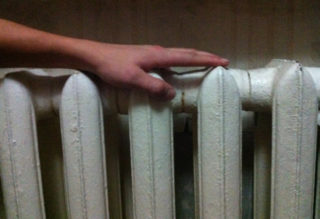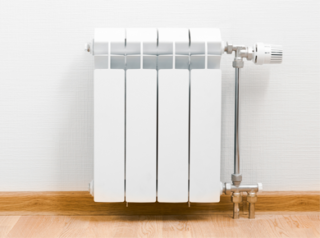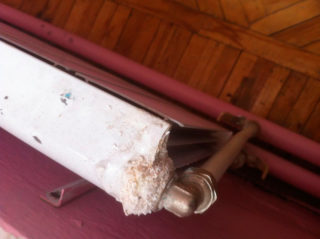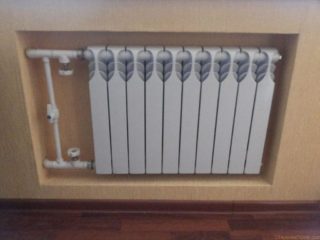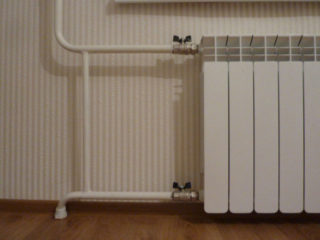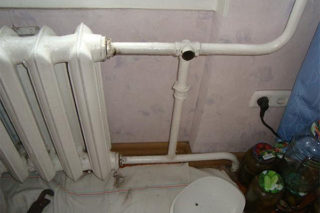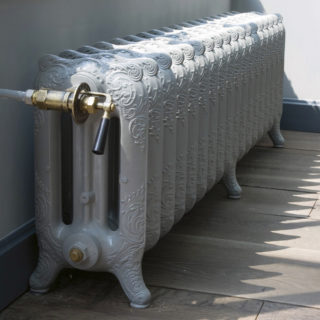The heating system in the house is an indispensable part of a comfortable existence. Sometimes it may be necessary to replace heating radiators, while residents need to figure out which batteries are best to choose.
Features of centralized heating in the apartment
An important advantage of apartment buildings over private cottages located outside the city limits is the constant heat supply. When the heating season begins, utilities give heat. But a centralized system has its drawbacks:
- Chemical impurities in water that goes through pipes. All of these substances can cause corrosion.
- Small particles can scratch the batteries from the inside. As a result, holes form and radiators will have to be changed.
- Unstable water temperature. At different times, batteries can be very hot or cold.
- Sudden increase in pressure. May cause an emergency.
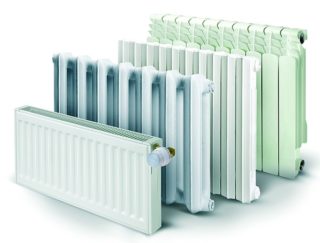
All this should be considered when choosing radiators for apartments. The main requirements include:
- The declared pressure must exceed the working pressure. For multi-story buildings, this figure should be 12-15 atmospheres.
- Resistance to hydroblow. It is better to choose stable models so that a sharp jump does not damage the heating system.
- The materials from which radiators are made must be resistant to corrosion and not destroyed by the action of particles of dirt, sand or stones.
- High heat dissipation. The main task of the radiator is to heat the home. Therefore, it is important to choose the model that will produce the greatest amount of heat without loss under given conditions.
- Service life, working conditions.
It is important to pay attention to the appearance. Efficiency does not depend on this indicator, but the design of the room should be taken into account.
Varieties of radiators for apartment buildings
In modern homes, models of steel, cast iron, aluminum and other materials show the greatest efficiency. There may be plastic inserts. They are distinguished by their resistance to water and impurities, their useful life, appearance and quality of heat transfer.
Steel batteries
Steel heating radiators are lightweight and thin. They are economical and efficient due to their high heat transfer and low water volume. The cost is low, but there is a factor limiting their use in the apartment: a steel radiator withstands a maximum of 8 atmospheres. Steel tubular batteries vary in design and design.
The positive aspects of steel heating radiators include:
- Light weight. Allows easy installation of batteries.
- Small thickness.
- Heat transfer is carried out directly and by convection. The combination of two heating methods gives good heat transfer rates.
- Easy installation.
- There are models with a different number of convectors.
- Affordable cost.
- High speed space heating.
- High demands are made on the quality of the coolant.
All the disadvantages relate to the use in apartments with a centralized heating system. Due to the compact design, a small volume of water will fit in it. This means that the battery will often have to be turned on in order to maintain optimal temperature conditions.When using an autonomous heating system, a large resource will be spent on heating.
Steel Tubular Radiators
Compared to the panel design, tubular batteries are made of individual parts in the form of tubes. They are connected to each other by welding. For installation in the house, a product is selected for the declared dimensions. Because of this, they cannot be expanded or replaced by broken sectional sections.
They have a small working pressure, so it is recommended to purchase an additional gearbox to protect against water hammer.
Main advantages:
- Light weight. Allows easy installation of the device.
- Resistance to corrosion. Unlike panel models, rust does not form on tubular radiators.
- Affordable cost.
- A wide range of sizes and colors.
- Fast heating.
- Low requirements for the quality of the heat carrier.
- Soldered together parts exclude the possibility of leakage.
Among the disadvantages, the risks of pneumatic shock due to the monolith and low heat transfer can be distinguished. Not suitable for houses with a central heating system.
Aluminum radiators
Euro aluminum batteries look stylish in appearance and give 190 watts of thermal power. But they are also used infrequently. Water with impurities has a high acidity, which destroys aluminum from the inside. A lot of pressure also harms the radiator.
The advantages of aluminum radiators in the apartment:
- Ease. Their weight is about 4 times less than cast iron.
- Easy installation. You can perform the installation yourself according to the instructions.
- Stylish appearance. Manufacturers offer a wide selection of colors and sizes.
- Cost. Products are inexpensive, in particular cheaper than bimetallic models.
- High degree of heat transfer.
Disadvantages:
- Poorly tolerate water hammer. The reason is the instability of aluminum.
- High demands are made on the coolant.
- Abrasive materials can damage the radiator from the inside. The acidity of water also has a negative effect on the integrity of the product.
- The most admissible working pressure - 12 atmospheres. In a centralized heating system, this value is 16 atmospheres.
- Short operating time.
Aluminum models are not suitable for use in the apartment as the main source of heat. In the case of autonomous heating, aluminum batteries for a house will show all their positive qualities.
Bimetal batteries
The latest developments include radiators made of two metals. Typically, copper and aluminum or steel and aluminum are used. An aluminum alloy is used for the ribbed body, and the core is steel or copper.
According to the manufacturers, the minimum service life is 40 years. Such models are well suited for apartments. They are able to withstand heat up to 130 ° C. Working pressure reaches 30-50 atmospheres, depending on the model and its characteristics. Resistant to water hammer.
Radiators have a corrosion-resistant coating and an internal primer. Thanks to this coating, water impurities and small pebbles will not destroy the batteries.
Devices are mobile due to their low weight. Installation does not cause difficulties, it is enough to do everything according to the instructions. Appearance is esthetic, there are white and color panels.
The main advantages of bimetallic models:
- Sustainability. They can operate at high pressure and temperature spikes.
- They are not affected by water acidity.
- Good heat dissipation.
- Water hammer virtually no negative impact.
- There are practically no requirements for the coolant.
- Light weight and easy installation.
- Stylish design.
- The service life reaches 50 years.
Of the minuses, you can highlight the high cost of the device. It is better to buy indoor models from well-known manufacturers. Popular are the Russian batteries in the Rifar apartment, the Italian ones - Sira or Global, as well as Zehnder. Some Chinese manufacturers also offer quality products at prices below European. You can buy Rifar devices at any store.
Cast Iron Radiators
Cast iron models are distinguished by their strength and durability. They have long been used in the heating system and do an excellent job of their duties. They are practically not affected by the quality of water, its level of acidity and impurities. The walls are thick, so the abrasive can not damage them from the inside. Cast iron radiator batteries are most often used in apartments.
Indisputable advantages include the ability to keep warm for a long time. The residual amount of heat is 30% - this is higher than that of radiators made of other materials. The method of heating the room is radiation. It is more efficient than convection.
The pluses also include:
- heating not only air, but also objects;
- large heat transfer area;
- resistance to pressure drops;
- unpretentiousness;
- inertia;
- low price;
- quality, durability, reliability;
- durability;
- compatibility with pipes made of various materials;
- simplicity of operation;
- lack of heat carrier requirements;
- rust does not form.
Despite all the resistance of the material, it may not withstand water hammer. Operating pressure reaches an average of 16 atmospheres. They are also distinguished by their large weight, which makes them inconvenient to mount.
Modern cast-iron heating batteries have a stylish appearance. Models of figured and retro-style appear.
Choosing the best model for an apartment
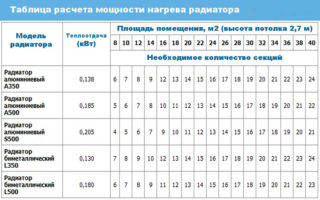 After studying the characteristics of all types of radiators, you can begin to choose the best product in the house. According to the described properties in central heating, steel and aluminum models immediately disappear. They will not stand the test of domestic coolant, so you should choose cast-iron and bimetallic devices.
After studying the characteristics of all types of radiators, you can begin to choose the best product in the house. According to the described properties in central heating, steel and aluminum models immediately disappear. They will not stand the test of domestic coolant, so you should choose cast-iron and bimetallic devices.
The further choice depends on the budget that the buyer is willing to spend on heating radiators. Cast iron appliances can be installed in old houses. If the pressure of the heating system is higher in a multi-story building, a choice should be made in favor of bimetallic radiators.
What criteria should be considered when choosing a radiator:
- Maximum pressure in the central heating system. Radiator limit must be higher.
- Temperature limit. Endurance of the battery to temperature influences. Lower temperatures should also be considered.
- The material of manufacture.
- Appearance.
- Power. The quantity and size of sections depends on this indicator. Calculations are made in accordance with the proposed building codes and rules.
If the house has an autonomous heating system, you can buy any radiator. In this case, it is more profitable to supply aluminum devices in terms of price, quality and heat transfer.
It is important to consider the combination of materials. If you connect expensive high-quality batteries to pipes that are incompatible in material, the efficiency will be significantly reduced. In addition, the radiator may fail.
